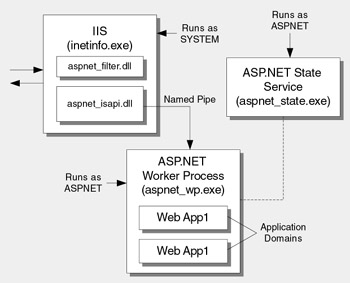ASP.NET Architecture on Windows 2000
On Windows 2000, multiple Web applications run in a single instance of the ASP.NET worker process (Aspnet_wp.exe). Each application resides in its own application domain that provides a degree of isolation for managed code. The Windows 2000/IIS 5 architecture is shown in Figure 20.1.

Figure 20.1: ASP.NET architecture on Windows 2000 with IIS 5
The components of the architecture depicted by Figure 20.1 are summarized in Table 20.2.
| Component | Description |
|---|---|
| Inetinfo.exe | The main IIS process. A Windows service that runs under the local SYSTEM account. |
| Aspnet_isapi.dll | IIS script mappings associate ASP.NET file types with this ASP.NET ISAPI extension that runs inside Inetinfo.exe. It is responsible for forwarding requests to the ASP.NET worker process through an asynchronous named pipe. It also starts the worker process and performs health monitoring. The ISAPI extension contains no managed code and performs no request processing itself. |
| Aspnet_filter.dll | A lightweight ISAPI filter used only to support cookie-less session state for ASP.NET applications. Runs inside Inetinfo.exe. |
| Aspnet_wp.exe | The ASP.NET worker process. Hosts multiple Web applications in separate application domains that are used to provide isolation. Generally one instance per server, although on multi-processor servers, a Web garden mode supports multiple identical processes with an affinity for a given processor. It is not possible to separate specific Web applications into different processes. This requires IIS 6 and Windows Server 2003. Aspnet_wp.exe runs under the local ASPNET account, although a custom account can be used. |
| Aspnet_state.exe | An optional Windows service used to store session state for ASP.NET applications. It can run on the Web server or on a remote machine (required for Web farm scenarios). It runs under the local ASPNET account, although a custom account can be used, configured via the Services snap-in. |
EAN: 2147483647
Pages: 613